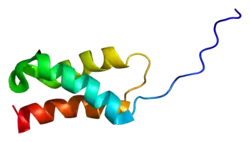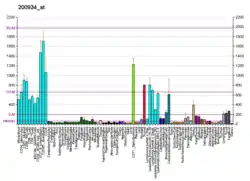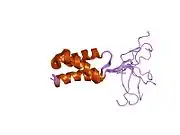DEK (gene)
Function
This gene encodes a protein with one SAP domain. The protein binds to cruciform and superhelical DNA and induces positive supercoils into closed circular DNA. It is also involved in splice site selection during mRNA processing. Chromosomal aberrations involving this region increased expression of this gene and the presence of antibodies against this protein are all associated with various diseases.[6]
References
- GRCh38: Ensembl release 89: ENSG00000124795 - Ensembl, May 2017
- GRCm38: Ensembl release 89: ENSMUSG00000021377 - Ensembl, May 2017
- "Human PubMed Reference:". National Center for Biotechnology Information, U.S. National Library of Medicine.
- "Mouse PubMed Reference:". National Center for Biotechnology Information, U.S. National Library of Medicine.
- von Lindern M, Fornerod M, van Baal S, Jaegle M, de Wit T, Buijs A, Grosveld G (Apr 1992). "The translocation (6;9), associated with a specific subtype of acute myeloid leukemia, results in the fusion of two genes, dek and can, and the expression of a chimeric, leukemia-specific dek-can mRNA". Mol. Cell. Biol. 12 (4): 1687–97. doi:10.1128/mcb.12.4.1687. PMC 369612. PMID 1549122.
- "Entrez Gene: DEK DEK oncogene (DNA binding)".
- Campillos M, García MA, Valdivieso F, Vázquez J (Mar 2003). "Transcriptional activation by AP-2alpha is modulated by the oncogene DEK". Nucleic Acids Res. 31 (5): 1571–5. doi:10.1093/nar/gkg247. PMC 149840. PMID 12595566.
Further reading
- von Lindern M, Fornerod M, Soekarman N, van Baal S, Jaegle M, Hagemeijer A, Bootsma D, Grosveld G (1992). "Translocation t(6;9) in acute non-lymphocytic leukaemia results in the formation of a DEK-CAN fusion gene". Baillière's Clinical Haematology. 5 (4): 857–79. doi:10.1016/s0950-3536(11)80049-1. PMID 1308167.
- Waldmann T, Scholten I, Kappes F, Hu HG, Knippers R (2004). "The DEK protein--an abundant and ubiquitous constituent of mammalian chromatin". Gene. 343 (1): 1–9. doi:10.1016/j.gene.2004.08.029. PMID 15563827.
- Denisenko ON, O'Neill B, Ostrowski J, Van Seuningen I, Bomsztyk K (1996). "Zik1, a transcriptional repressor that interacts with the heterogeneous nuclear ribonucleoprotein particle K protein". J. Biol. Chem. 271 (44): 27701–6. doi:10.1074/jbc.271.44.27701. PMID 8910362.
- Fu GK, Grosveld G, Markovitz DM (1997). "DEK, an autoantigen involved in a chromosomal translocation in acute myelogenous leukemia, binds to the HIV-2 enhancer". Proc. Natl. Acad. Sci. U.S.A. 94 (5): 1811–5. Bibcode:1997PNAS...94.1811F. doi:10.1073/pnas.94.5.1811. PMC 19999. PMID 9050861.
- Murray KJ, Szer W, Grom AA, Donnelly P, Levinson JE, Giannini EH, Glass DN, Szer IS (1997). "Antibodies to the 45 kDa DEK nuclear antigen in pauciarticular onset juvenile rheumatoid arthritis and iridocyclitis: selective association with MHC gene". J. Rheumatol. 24 (3): 560–7. PMID 9058666.
- Forero L, Zwirner NW, Fink CW, Fernández-Viña MA, Stastny P (1998). "Juvenile arthritis, HLA-A2 and binding of DEK oncogene-peptides". Hum. Immunol. 59 (7): 443–50. doi:10.1016/S0198-8859(98)00034-2. PMID 9684994.
- Dong X, Michelis MA, Wang J, Bose R, DeLange T, Reeves WH (1998). "Autoantibodies to DEK oncoprotein in a patient with systemic lupus erythematosus and sarcoidosis". Arthritis Rheum. 41 (8): 1505–10. doi:10.1002/1529-0131(199808)41:8<1505::AID-ART23>3.0.CO;2-N. PMID 9704652.
- Wichmann I, Garcia-Lozano JR, Respaldiza N, Gonzalez-Escribano MF, Nuñez-Roldan A (1999). "Autoantibodies to transcriptional regulation proteins DEK and ALY in a patient with systemic lupus erythematosus". Hum. Immunol. 60 (1): 57–62. doi:10.1016/S0198-8859(98)00085-8. PMID 9952027.
- Alexiadis V, Waldmann T, Andersen J, Mann M, Knippers R, Gruss C (2000). "The protein encoded by the proto-oncogene DEK changes the topology of chromatin and reduces the efficiency of DNA replication in a chromatin-specific manner". Genes Dev. 14 (11): 1308–12. PMC 316669. PMID 10837023.
- McGarvey T, Rosonina E, McCracken S, Li Q, Arnaout R, Mientjes E, Nickerson JA, Awrey D, Greenblatt J, Grosveld G, Blencowe BJ (2000). "The acute myeloid leukemia-associated protein, DEK, forms a splicing-dependent interaction with exon-product complexes". J. Cell Biol. 150 (2): 309–20. doi:10.1083/jcb.150.2.309. PMC 2180225. PMID 10908574.
- Grottke C, Mantwill K, Dietel M, Schadendorf D, Lage H (2000). "Identification of differentially expressed genes in human melanoma cells with acquired resistance to various antineoplastic drugs". Int. J. Cancer. 88 (4): 535–46. doi:10.1002/1097-0215(20001115)88:4<535::AID-IJC4>3.0.CO;2-V. PMID 11058868.
- Le Hir H, Izaurralde E, Maquat LE, Moore MJ (2000). "The spliceosome deposits multiple proteins 20-24 nucleotides upstream of mRNA exon-exon junctions". EMBO J. 19 (24): 6860–9. doi:10.1093/emboj/19.24.6860. PMC 305905. PMID 11118221.
- Kappes F, Burger K, Baack M, Fackelmayer FO, Gruss C (2001). "Subcellular localization of the human proto-oncogene protein DEK". J. Biol. Chem. 276 (28): 26317–23. doi:10.1074/jbc.M100162200. PMID 11333257.
- Waldmann T, Eckerich C, Baack M, Gruss C (2002). "The ubiquitous chromatin protein DEK alters the structure of DNA by introducing positive supercoils". J. Biol. Chem. 277 (28): 24988–94. doi:10.1074/jbc.M204045200. PMID 11997399.
- Larramendy ML, Niini T, Elonen E, Nagy B, Ollila J, Vihinen M, Knuutila S (2002). "Overexpression of translocation-associated fusion genes of FGFRI, MYC, NPMI, and DEK, but absence of the translocations in acute myeloid leukemia. A microarray analysis". Haematologica. 87 (6): 569–77. PMID 12031912.
- Hollenbach AD, McPherson CJ, Mientjes EJ, Iyengar R, Grosveld G (2002). "Daxx and histone deacetylase II associate with chromatin through an interaction with core histones and the chromatin-associated protein Dek". J. Cell Sci. 115 (Pt 16): 3319–30. PMID 12140263.
- Krithivas A, Fujimuro M, Weidner M, Young DB, Hayward SD (2002). "Protein interactions targeting the latency-associated nuclear antigen of Kaposi's sarcoma-associated herpesvirus to cell chromosomes". J. Virol. 76 (22): 11596–604. doi:10.1128/JVI.76.22.11596-11604.2002. PMC 136775. PMID 12388720.
External links
- PDBe-KB provides an overview of all the structure information available in the PDB for Human Protein DEK
This article is issued from Wikipedia. The text is licensed under Creative Commons - Attribution - Sharealike. Additional terms may apply for the media files.






